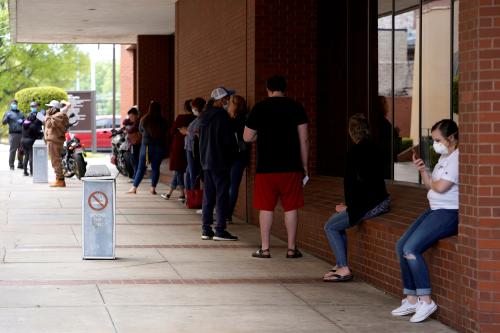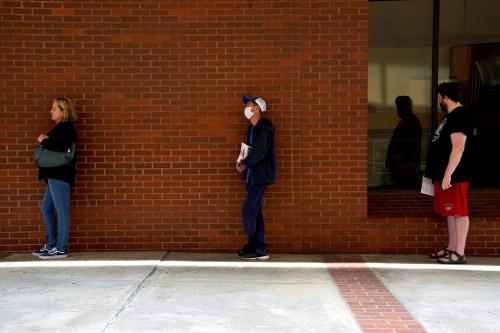A startling indicator of the economic impact of COVID-19 is that unemployment rates reached the highest level since the Great Depression in April. As a result, claims for unemployment benefits have risen dramatically, though millions of people who have lost their jobs have been unable to apply or have had trouble applying for this benefit. Yet these figures do not reveal the extent to which households are struggling financially as a result of a COVID-19 related job loss.
To report findings about COVID-19 job and income losses and financial hardships, the Social Policy Institute at Washington University in St. Louis administered a unique nationally representative survey to 5,500 respondents from April 27 to May 12 . A job loss is one of the worst financial shocks most families will face, making it extremely difficult to make ends meet and avoid devastating downstream effects like foreclosures or evictions. During the COVID-19 pandemic, unemployment reached historic heights with more than 40 million unemployment benefit claims filed—even exceeding the unemployment levels during the Great Depression
Impacts of COVID-19 on job loss
The survey found that 24 percent of respondents lost a job or income due to COVID-19. Most of these job or income losses were due to being furloughed or experiencing reduced work hours.
However, these job and income losses were not experienced equally. Hispanic, low-income, and young individuals (between the ages of 18 and 24) had the highest rates of job and income loss compared to other racial/ethnic, income, and age groups, as reflected in the charts below.



While job and income loss rates were very similar among moderate-, middle-, and high-income respondents, low-income and Hispanic respondents—those least able to cope with economic shocks—had a distinctly higher rate of job and income loss. That job and income losses were highest among Hispanic respondents is likely related to their disproportionate representation in industries hard hit by COVID-19 related layoffs such as hospitality and construction. Conversely, black workers are disproportionately represented in industries such as health care and transportation that have been less affected.
Differences in COVID-19 related job and income losses were most pronounced by age. Young adults between the ages of 18 to 24 experienced job or income losses nearly twice as much as older age groups.
Yet are COVID-19 related job and income losses affecting the ability of U.S. households to make ends meet? One way to know is to look at different types of economic hardship, such as difficulty paying for housing and other bills, putting off medical care and filling prescriptions, and experiencing food insecurity. As the graph below indicates, COVID-19 related job and income losses are clearly related to increased hardship such as difficulty making housing payments—even after controlling for income, age, gender, and household size (Figure 4).

Households that experienced a COVID-19-related job or income loss were two to three times more likely to experience economic hardship than those who did not experience a loss, with all of these differences being statistically significant (p < .001). These hardships reflect important aspects of family well-being related to housing, nutrition, and health.
Other factors, such as race and ethnicity or income, increased the chances of respondents reporting hardships. Compared to white households, black households had significantly higher chances of difficulties making housing and other bill payments (p < .001) and putting off filing prescriptions (p < .05). Also, Hispanic households had a much greater chance of experiencing food insecurity (p < .001) compared to white households. As can be expected, the chances of experiencing hardship were much higher for low-income compared to moderate-, middle-, and high-income households for all types of hardship.
Survey respondents were also asked whether COVID-19 has made it hard to afford food for the adults and children in their households. Again, COVID-19 job and income loss is a significant factor. Households experiencing a job or income loss were more than twice as likely to have a hard time paying for food for adults, after controlling for income, age, gender, and household size (Figure 5).

Consequences of economic hardship
These survey findings illustrate that the economic pain of families who have lost jobs or income due to COVID-19 is very real. These findings look beyond the official unemployment and job loss figures to see just how affected families are struggling. These findings are particularly notable given that the survey administered by Social Policy Institute was conducted early in the pandemic (April 2020) and is the first of several waves administered every three months in 2020.
The hardships presented here have many negative consequences for households. Difficulty paying rent puts households and families at risk for eviction, especially when eviction moratoria some municipalities implemented expire and households struggle to pay back-due rent. The negative downstream effects of eviction are varied and far-reaching: loss of possessions, disruptive school changes, loss of friends for children, and mental health distress just to name a few.
The health consequences of food insecurity are far-reaching. Among children, consequences include birth defects, anemia, asthma, and cognitive, behavioral, and mental health problems. Compounding these issues, individuals may put off medical care or avoid filling prescriptions as a result of the high cost and loss of income. These individuals jeopardize their health, especially if they have serious or chronic illnesses.
Helping families cope with job and income loss during the COVID-19 pandemic
The federal Coronavirus Aid, Relief, & Economic Security (CARES) Act signed into law in late March 2020 includes various provisions that ought to help many struggling families, including extended unemployment benefits and economic impact payments. However, CARES Act limitations calling for additional policy responses remain:
- Additional unemployment benefit payments of $600 a week are set to expire in July 2020. Laid-off workers in hard-hit industries like hospitality that will take longer to recover will struggle if they lose these extra payments.
- No provision for expanded health coverage or help to transition to Affordable Care Act plans for workers who lost health insurance when they were laid off or for furloughed workers who could not afford their insurance premiums.
- No provision for expanding and extending direct rental assistance. While many municipalities and states have implemented eviction moratoriums, many are set to expire in July, or when disaster or public health emergency declarations expire. A looming eviction crisis is on the horizon among tenants who won’t be able to pay back-due rent. However, Congress can pass additional legislation regarding emergency housing assistance and use the COVID-19 crisis as an opportunity to tackle the country’s affordable housing crisis.
The Brookings Institution is committed to quality, independence, and impact.
We are supported by a diverse array of funders. In line with our values and policies, each Brookings publication represents the sole views of its author(s).










Commentary
COVID-19 job and income loss leading to more hunger and financial hardship
July 13, 2020